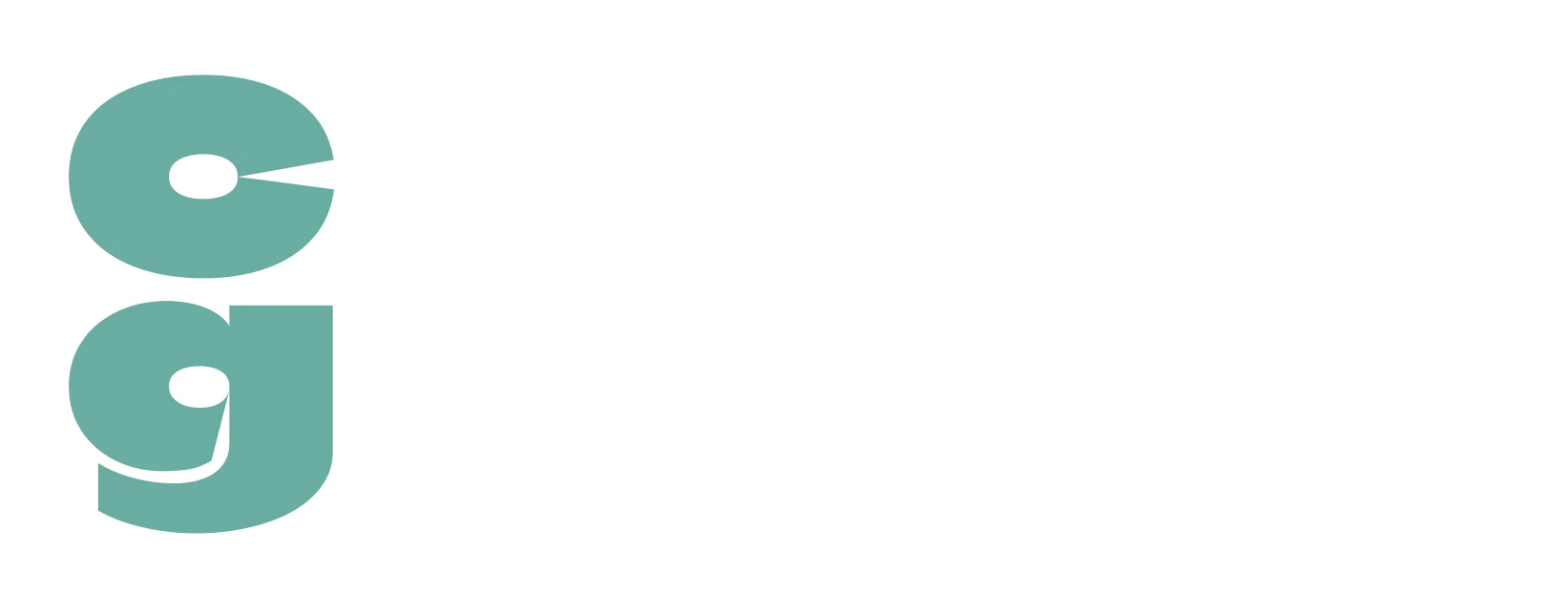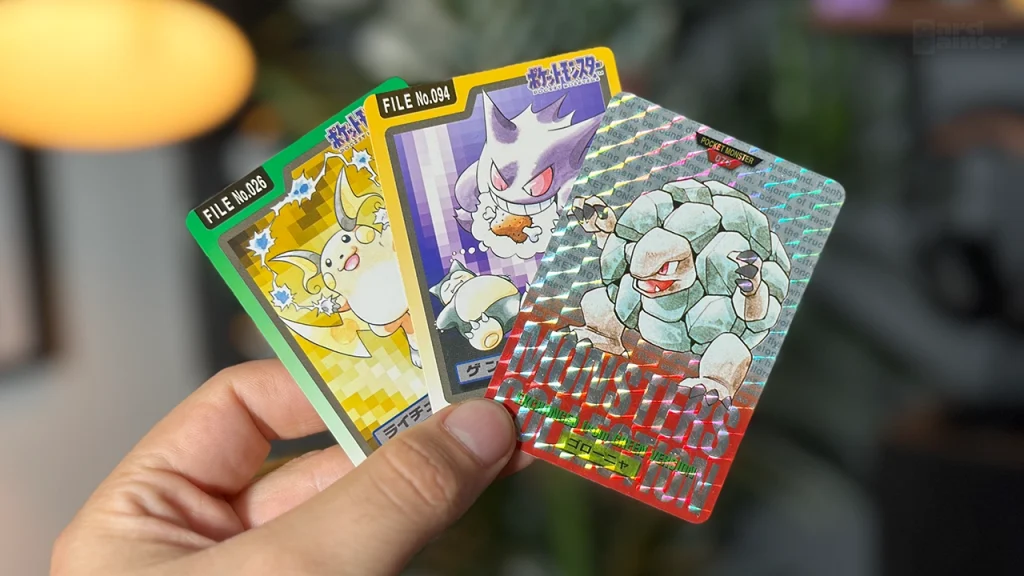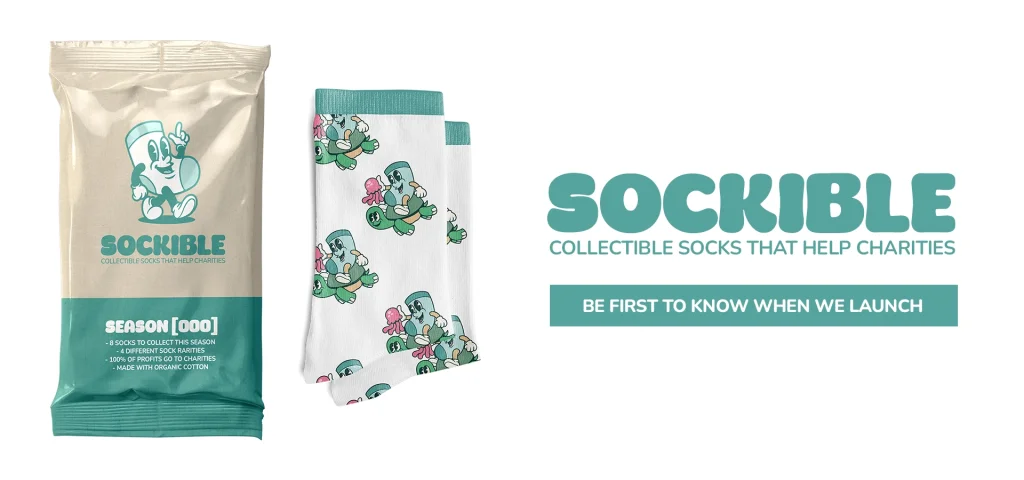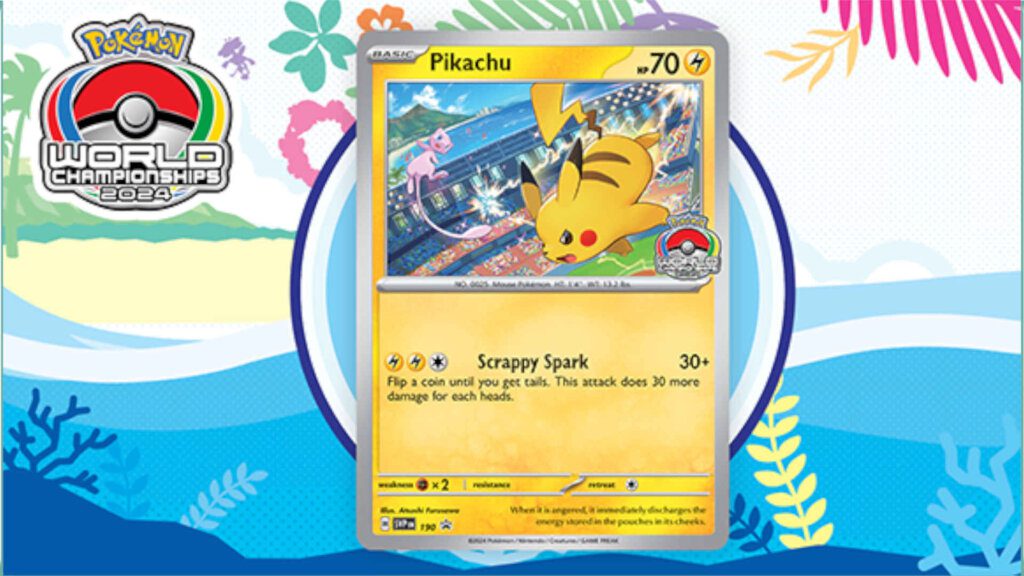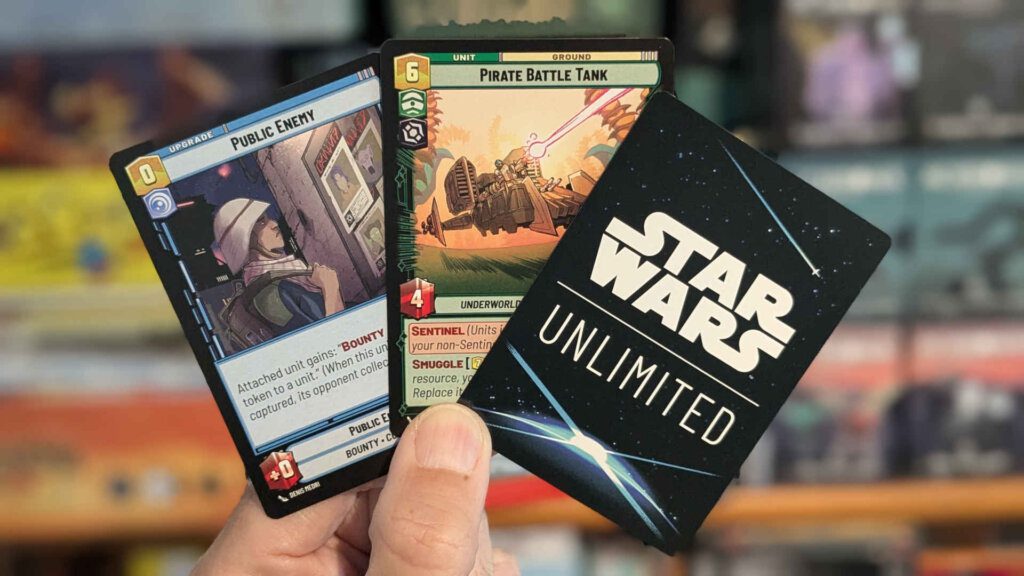Before the Pokemon TCG graced shelves in Japan, Pokemon Carddass sets were the only collectible cards Pokemon fans could buy.
Collectors prize Carddass cards as they are the oldest Pokemon cards ever printed.
Topsun Pokemon cards are often mistakenly attributed as the first Pokemon cards ever printed. While these cards had a more significant impact than Carddass cards, thanks to the greater number of cards, they were not printed until two years after the first Carddass cards.
Today, these Carddass Pokemon cards are not just valuable collector’s items but a fascinating peek into the early world of Pokemon.
Table of Contents
ToggleWhat does Carddass mean?
Carddass refers to the name Bandai gave to their range of card vending machines, which still operate today. These machines mostly dispensed cards based on anime and manga, but a few were inspired by video games, notably their Pokemon cards.
Carddass does not refer to the machines that dispensed Pokemon cards.
Instead, it is a registered trademark that serves as a generic term for all Bandai’s card vending machines. Thus, these cards should be called “Bandai Carddass Pokemon cards” to differentiate them from other popular Carddass cards.
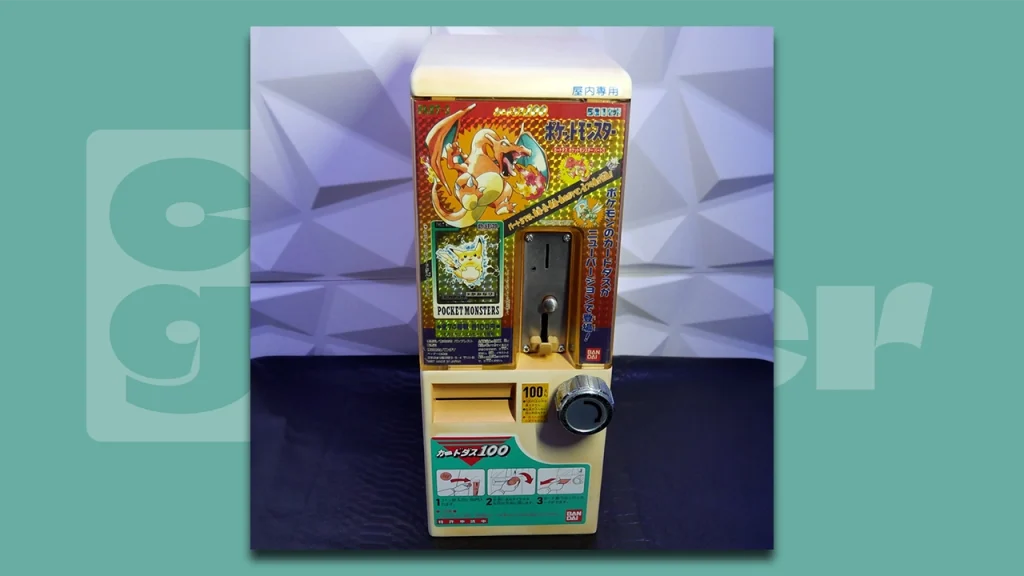
These super rare vending machines have been listed on eBay for approximately $30,000.
What are Carddass Pokemon cards?
Unlike Topsun’s Pokemon cards, Bandai manufactured cards as standalone products, not to promote an existing product (Gum in Topsun’s case). However, they are similar in that these are purely collectible items that cannot be used to play a tabletop game.
The original Cardass Pokemon cards exclusively featured the 151 Pokemon from Generation 1, including Mew, which was strangely absent from the first Topsun cards.
Bandai produced four sets of Carddass Pokemon cards between 1996 and 1997.
The sets have few similarities, although the layout displaying a Pokemon on the front and relevant information on the back remained unchanged throughout the print run.
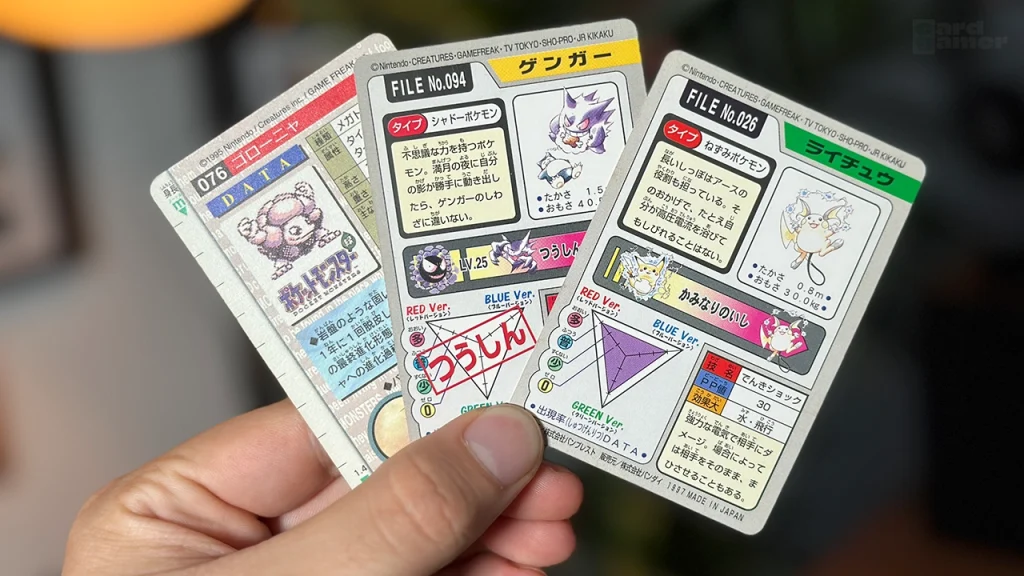

After these cards, Carddass produced cards based on the Pokemon anime and its spin-off movies until 2000.
Ken Sugimori, the leading illustrator for the Pokemon franchise, designed the original artwork on Carddass cards.
However, most of these were not unique to Carddass; the artwork on the first two batches of Carddass Pokemon cards was copied straight from the official Pokemon Red & Green artwork.
As Bandai printed the Carddass Pokemon cards mere months after the release of Pokemon Red & Green, these may have been part of a promotional agreement between Bandai and Game Freak.
However, no official records of such an agreement exist. Bandai regularly printed Carddass cards based on popular franchises, so their Pokemon cards were more likely an attempt to jump on the latest craze.
When were Carddass Pokemon cards first printed?
Bandai does not offer an official date for the first Carddass Pokemon cards, but the August edition of Shogakukan’s CoroCoro magazine featured an advertisement for Cardass Pokemon cards.
This advert stated that the first Pokemon Cardass cards would be available between September 21-30, 1996.
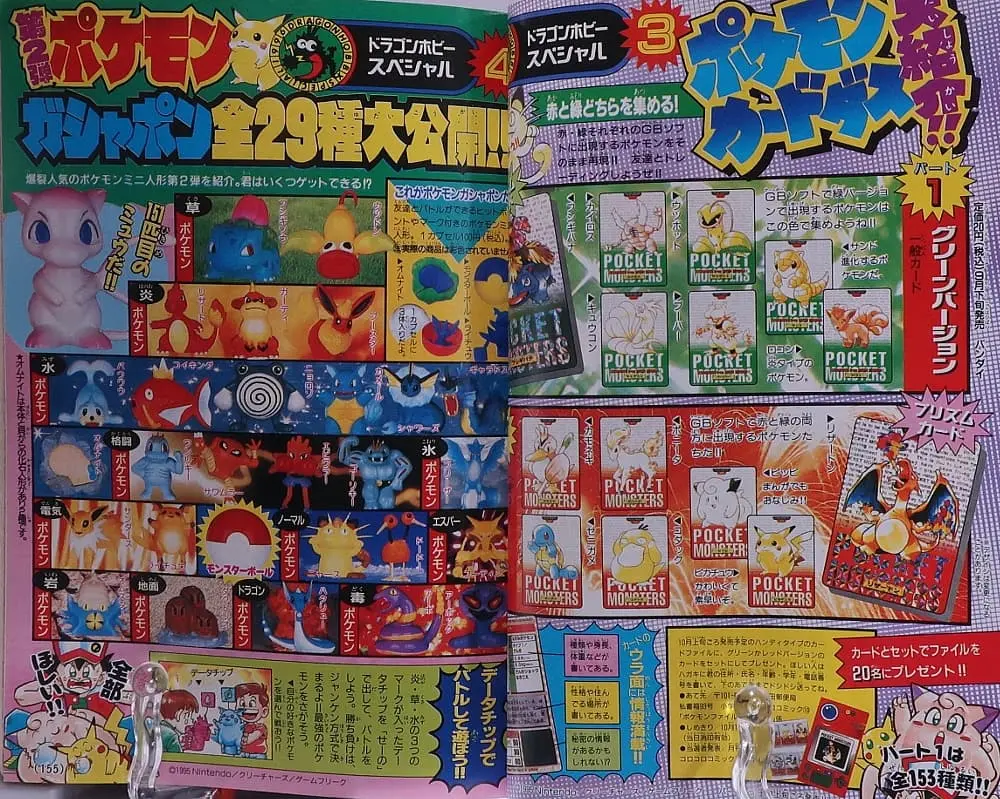

The release date of the Pokemon TCG is well known to be October 1996, so while it’s close, Carddass Pokemon cards are the first Pokemon cards ever printed.
The first cards also featured a Bandai 1996 copyright date confirming the year.
In 1996, a pack of five Carddass cards cost ¥100/$1.00, while individual cards cost ¥20 yen/$0.20.
Bandai produced a set of cards based on Pokemon Red & Green, then another based on Pokemon Blue.
Bandai split these sets into two parts, each containing half the set.
- Set 1 Part 1: September 1996
- Set 1 Part 2: October 1996
- Set 2 Part 1: 1997 (month unknown)
- Set 2 Part 2: 1997 (month unknown)
How many Carddass Pokemon cards are there?
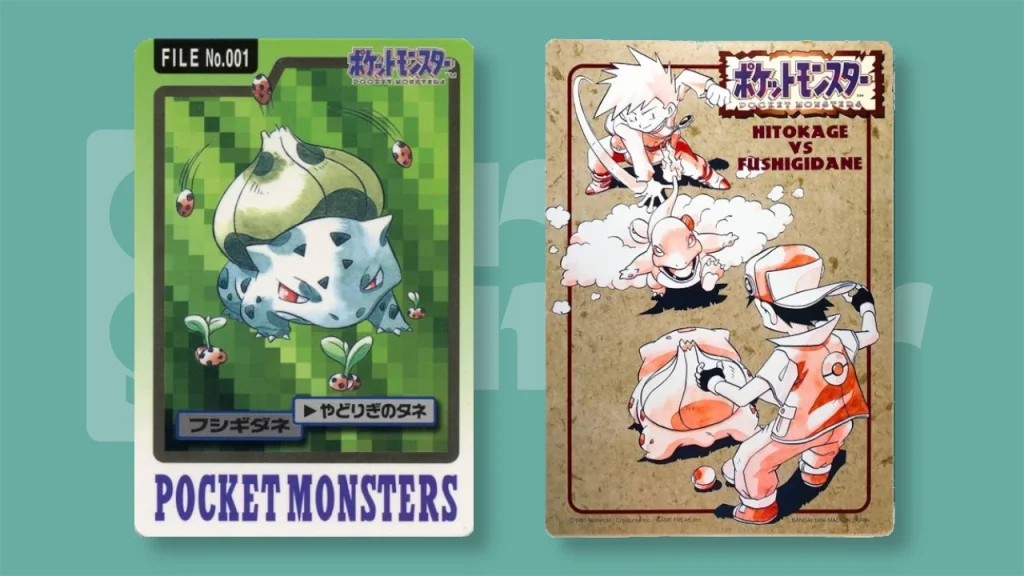

Identifying and counting Carddass Pokemon cards from the first two sets is easy, but later cards are much harder to identify.
Most cards were only available through the Carddass machines, although some promotional cards could only be found in certain stores.
Carddass Part 1 and 2 (Set 1)
Together, the first set of Bandai Carddass Pokemon cards includes all 151 Pokemon from Gen 1, plus extra cards showing the Kanto region map and a list of the set’s cards.
These were printed as two parts but were designed to form one complete collection. There are 158 cards from this set.
Carddass Part 1 included 78 cards: 75 Pokemon, two List cards, and one Map card. Carddass Part 2 included 80 cards: 76 Pokemon, two List cards, and two Map cards.
Each Pokemon card featured a red and green variant but were otherwise identical.
Some were exclusively holographic (marked with an H in the table below). Holographic Carddass Pokemon cards included the final evolutions of each starter, Pokemon only obtainable by trading, and Legendaries.
| Cardass Set 1 Part 1 | Cardass Set 1 Part 2 | |||
| Card No. | Card Name | Card No. | Card Name | |
| 1 | Bulbasaur | 13 | Weedle | |
| 2 | Ivysaur | 14 | Kakuna | |
| 3 | Venusaur (H) | 23 | Ekans | |
| 4 | Charmander | 24 | Arbok | |
| 5 | Charmeleon | 32 | Nidoran | |
| 6 | Charizard (H) | 33 | Nidorino | |
| 7 | Squirtle | 43 | Oddish | |
| 8 | Wartortle | 44 | Gloom | |
| 9 | Blastoise (H) | 45 | Vileplume | |
| 10 | Caterpie | 56 | Mankey | |
| 11 | Metapod | 57 | Primeape | |
| 12 | Butterfree | 58 | Growlithe | |
| 15 | Beedrill | 59 | Arcanine | |
| 16 | Pidgey | 79 | Slowpoke | |
| 17 | Pidgeotto | 80 | Slowbro | |
| 18 | Pidgeot | 85 | Dodrio | |
| 19 | Rattata | 86 | Seel | |
| 20 | Raticate | 87 | Dewgong | |
| 21 | Spearow | 90 | Shellder | |
| 22 | Fearow | 91 | Cloyster | |
| 25 | Pikachu | 92 | Gastly | |
| 26 | Raichu | 93 | Haunter | |
| 27 | Sandshrew | 94 | Gengar (H) | |
| 28 | Sandslash | 95 | Onix | |
| 29 | Nidoran | 96 | Drowzee | |
| 30 | Nidorina | 97 | Hypno | |
| 31 | Nidoqueen | 100 | Voltorb | |
| 34 | Nidoking | 101 | Electrode | |
| 35 | Clefairy | 102 | Exeggcute | |
| 36 | Clefable | 103 | Exeggutor | |
| 37 | Vulpix | 104 | Cubone | |
| 38 | Ninetales | 105 | Marowak | |
| 39 | Jigglypuff | 106 | Hitmonlee | |
| 40 | Wigglytuff | 107 | Hitmonchan | |
| 41 | Zubat | 108 | Lickitung | |
| 42 | Golbat | 109 | Koffing | |
| 46 | Paras | 110 | Weezing | |
| 47 | Parasect | 111 | Rhyhorn | |
| 48 | Venonat | 112 | Rhydon | |
| 49 | Venomoth | 113 | Chansey | |
| 50 | Diglett | 114 | Tangela | |
| 51 | Dugtrio | 115 | Kangaskhan | |
| 52 | Meowth | 116 | Horsea | |
| 53 | Persian | 117 | Seadra | |
| 54 | Psyduck | 118 | Goldeen | |
| 55 | Golduck | 119 | Seaking | |
| 60 | Poliwag | 120 | Staryu | |
| 61 | Poliwhirl | 121 | Starmie | |
| 62 | Poliwrath | 122 | Mr. Mime | |
| 63 | Abra | 123 | Scyther | |
| 64 | Kadabra | 124 | Jynx | |
| 65 | Alakazam (H) | 125 | Electabuzz | |
| 66 | Machop | 128 | Tauros | |
| 67 | Machoke | 129 | Magikarp | |
| 68 | Machamp (H) | 130 | Gyarados | |
| 69 | Bellsprout | 131 | Lapras | |
| 70 | Weepinbell | 132 | Ditto | |
| 71 | Victreebel | 133 | Eevee | |
| 72 | Tentacool | 134 | Vaporeon | |
| 73 | Tentacruel | 135 | Jolteon | |
| 74 | Geodude | 136 | Flareon | |
| 75 | Graveler | 137 | Porygon | |
| 76 | Golem (H) | 138 | Omanyte | |
| 77 | Ponyta | 139 | Omastar | |
| 78 | Rapidash | 140 | Kabuto | |
| 81 | Magnemite | 141 | Kabutops | |
| 82 | Magneton | 142 | Aerodactyl | |
| 83 | Farfetch’d | 143 | Snorlax | |
| 84 | Doduo | 144 | Articuno (H) | |
| 88 | Grimer | 145 | Zapdos (H) | |
| 89 | Muk | 146 | Moltres (H) | |
| 98 | Krabby | 147 | Dratini | |
| 99 | Kingler | 148 | Dragonair | |
| 126 | Magmar | 149 | Dragonite | |
| 127 | Pinsir | 150 | Mewtwo (H) | |
| 152 | List card 1 | 151 | Mew (H) | |
| 153 | List card 2 | 154 | List card 3 | |
| 156 | Map card 1 | 155 | List card 4 | |
| 157 | Map card 2 | |||
| 158 | Map card 3 | |||
Cardass Pokemon cards from Parts 1 and 2 featured the Pokemon on the front with the text “MONSTERS COLLECTION” underneath and below.
The card was colored red or green behind this text, which faded into smaller text describing the world of “Pocket Monsters.” (The name Pokemon had not been formalized at this point).


The rear of each card featured stats relating to the Pokemon’s appearance in the Red & Green games. This included the appearance rate of each Pokemon, making them valuable companion tools for the games. This side of the cards also featured the sprite from the game’s Pokedex.
Carddass Part 3 and 4 (Set 2)
Parts 3 and 4 of the Cardass Pokemon cards received a distinct redesign. Bandai added original artwork, and updated the back of the cards to accommodate the recently released Pokemon Blue game.
Like the first set, cards from Parts 3 and 4 combined to form one complete set
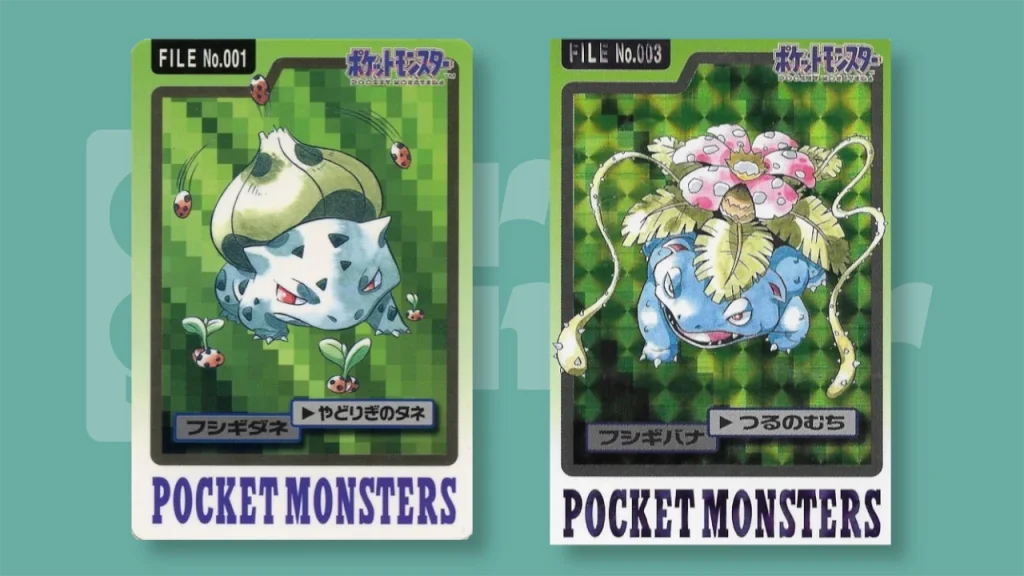

Unlike the first set, there is only one card for each Pokemon.
All 151 Pokemon from Gen 1 were included. Two promotional cards completed this set, but were only available through the Japanese department store Ito-Yokado.
Set 2 also included more holographic cards, including Pikachu, Clefairy, Eevee, and Aerodactyl.
This set is notable for its two promotional cards, one for each part. One featured Venusaur, Charizard, Blastoise, Red, and Blue, while the other featured Bulbasaur, Charmander, Squirtle, Pikachu, and Red.
These featured a rainbow border which is also found on Mew. The rear featured a list of all the cards in that part.
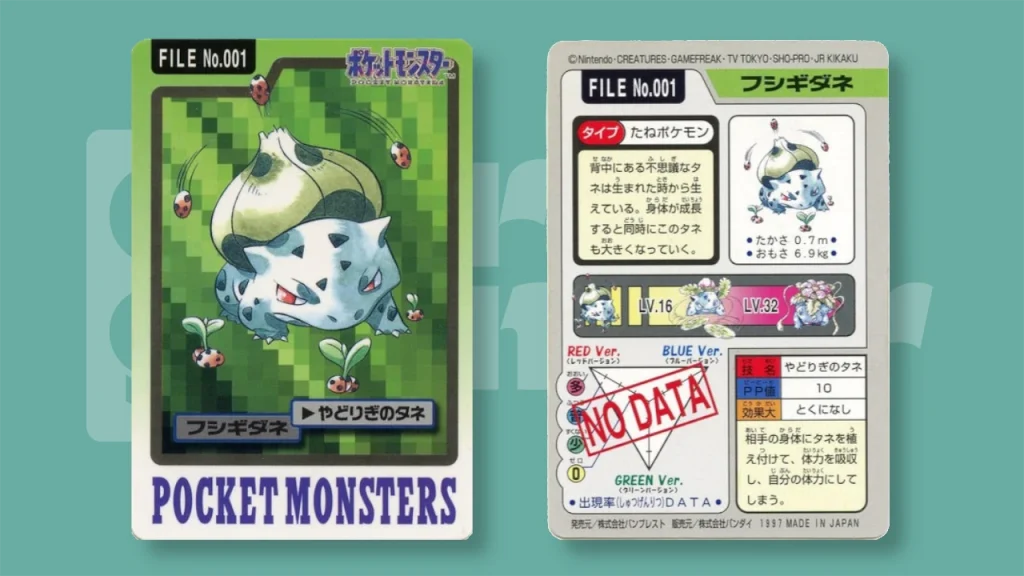

Apart from the promotional cards, each Carddass card from this set followed the same design. The artwork on the front of the card featured a colored background and border and the text of a signature move learned by that Pokemon (e.g., Blastoise and Hydro Pump).
The rear of these cards featured more information than Set 1. The evolution tree of the Pokemon appeared, as well as its chance of appearing in Pokemon Red, Green, and Blue.
Carddass Jumbo Cards
In 1996 (dated by the copyright on each card), Bandai released jumbo cards.
These featured removable stickers on the front, details of trainers from the Red, Green, and Blue games, and a map of Kanto on the back.
At least two of these cards featured a snapshot of a battle a player would encounter while playing Pokemon Red and Green.
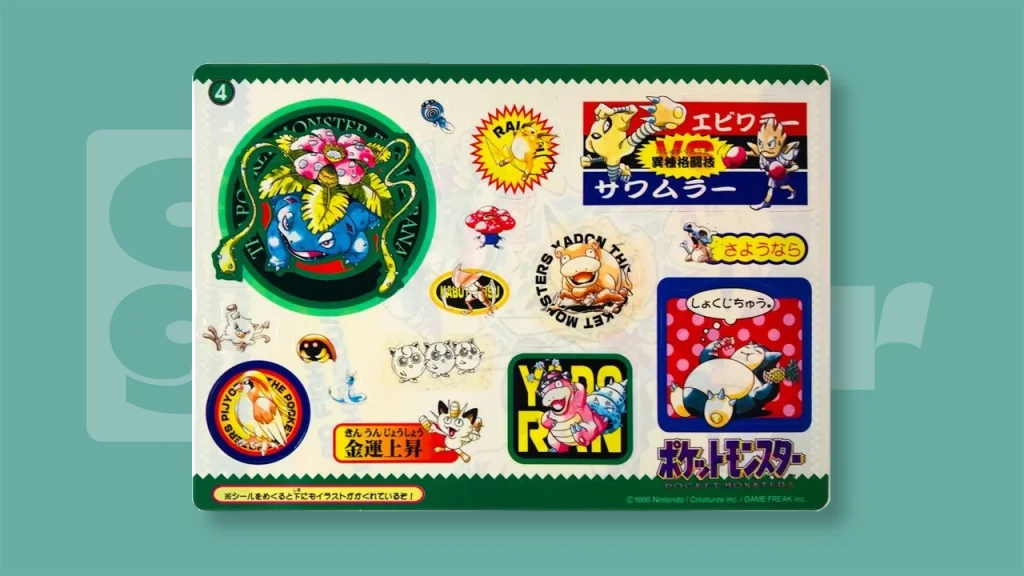

It is unclear how many cards were printed, some images show cards numbered 1-12, but auctions of these sets usually only comprise cards 1-6.
At the 1997 Tokyo Toy Show, visitors to the Bandai booth could receive a promotional jumbo Pikachu card. This card is identical to the Pikachu from Set 2 but non-holographic and much larger.
Carddass Anime Cards & Miscellaneous Cards
Between 1997 (the year the Pokemon anime premiered) and 2000, Bandai produced a variety of cards depicting scenes and characters from the Pokemon anime and movies. They printed these cards in standard and jumbo sizes.
These cards don’t follow a consistent design. Some were printed in landscape format, while others are portrait. Fans of the Pokemon anime and movies produced before 2001 will recognize many of the scenes shown.


Bandai also made various Pokemon cards that don’t fit any particular set.
These are hard to identify for non-Japanese speakers, but most will say CARDASS somewhere on the front.
How valuable Are Carddass Pokemon cards?
Despite being the first Pokemon cards ever made, Carddass Pokemon card prices do not reach the eye-watering heights of the Pokemon TCG. Even Topsun Pokemon cards sell for more.
PSA grades various Carddass Pokemon cards, including the less valuable ones depicting the Pokemon anime. But which is the most valuable?
Unsurprisingly, it’s a Charizard card, but it doesn’t reach the prices of the most valuable Charizard Pokemon cards from the trading card game.
A PSA Grade 10 of the 1996 Red Carddass Charizard sold for $7,900 in 2022, but a sale was recorded in 2021 of $30,000. The promotional cards from Parts 3 and 4 also fetch high prices; one sold for $3,000 in 2022.


Beyond these sets, Carddass Pokemon cards rarely sell for more than $100. Sets of unpeeled jumbo cards have fetched up to $600 at auction, but these are rare.
While Cardass Pokemon cards have never reached the popularity of the first Pokemon TCG cards, they are nevertheless a valuable addition to any collection.
How To Identify A Fake Carddass Pokemon Card?
Cardass Pokemon card fakes can be identified by elements common to all fake Pokemon cards. These include:
- Faded outline of the Pokemon.
- Holo versions of cards with no official holo variant.
- Incorrect Japanese text.
However, a few elements unique to Cardass Pokemon cards can help you identify a fake card if common signifiers are absent.
1. Incorrect Holographic Pattern
There is only one holographic pattern for the first two sets of Cardass Pokemon cards.
This diamond pattern covers everything but the Pokemon. Identifying a fake holographic pattern can be tough with two digital images, so we recommend comparing a digital image with a physical card.
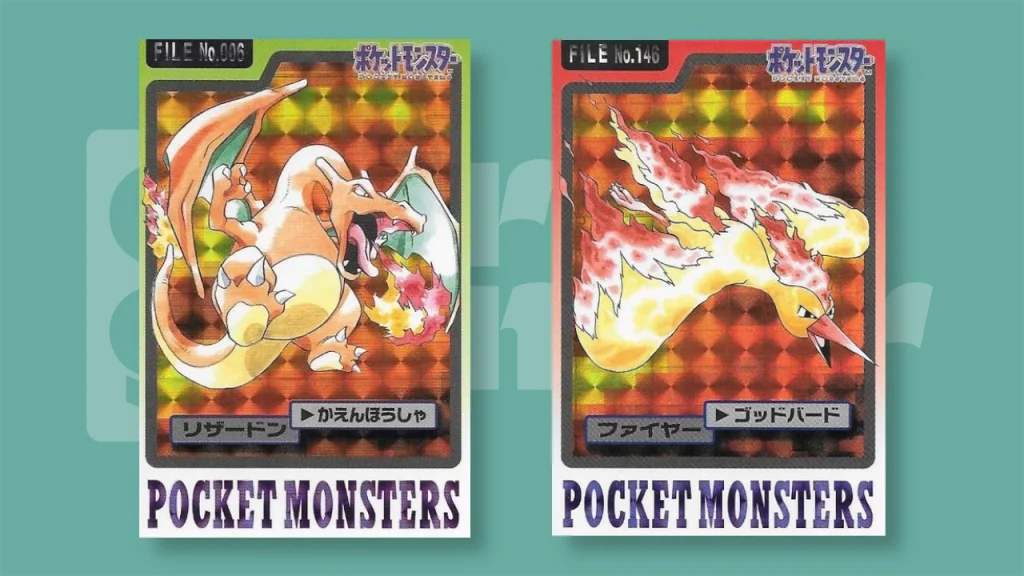

2. Missing Copyright Text
There are two copyrights that can appear on Bandai Cardass Pokemon cards. One refers to the Nintendo copyright, while the other is Bandai’s. The latter is the one you need to watch out for.
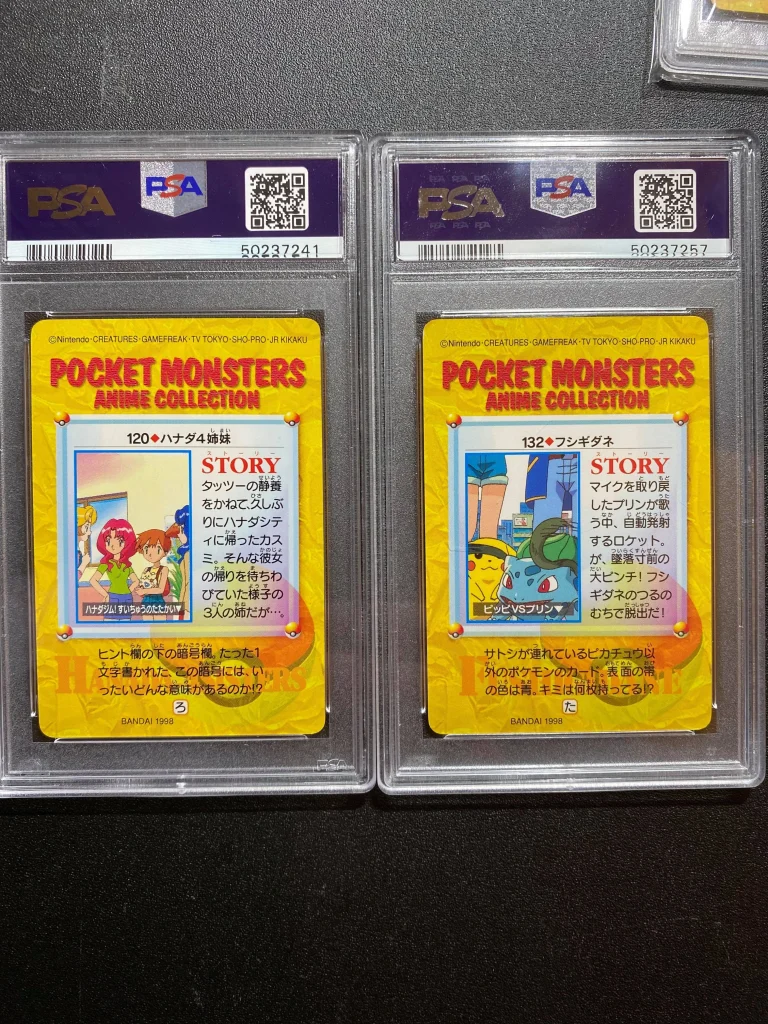

This text should read: ‘Bandai 1996 MADE IN JAPAN’. Though this is the case for most Carddass cards (and not just those made in 1996), do be aware that it’s not necessarily fake if it is missing the ‘MADE IN JAPAN’ text. According to one of our readers (thanks to Peter Shih for the information), who’s an experienced and knowledgeable collector of these cards, it is possible to find batches where that text is missing from the common, non-holo cards.
From what we’ve learned, we know that a version licensed in Hong Kong was published in 1998, printed and released in that territory and Taiwan. The ‘MADE IN JAPAN’ text is on the holofoil cards, but, as we’ve mentioned, not on the non-holos. In all other instances, and for cards manufactured in any other year except 1998, however, if the card is missing the ‘MADE IN JAPAN’ text, it’s a good sign that it’s fake.
3. Mismatched Back
Unlike Pokemon TCG cards, Bandai regularly changed the rear design of their Carddass Pokemon cards. Matching the front of the card with the back is an easy way to check an obvious fake.
Earlier in this article, we discussed the front and rear of the most popular Carddass cards earlier in this article. If you’re unsure about others, check images of professionally graded cards.
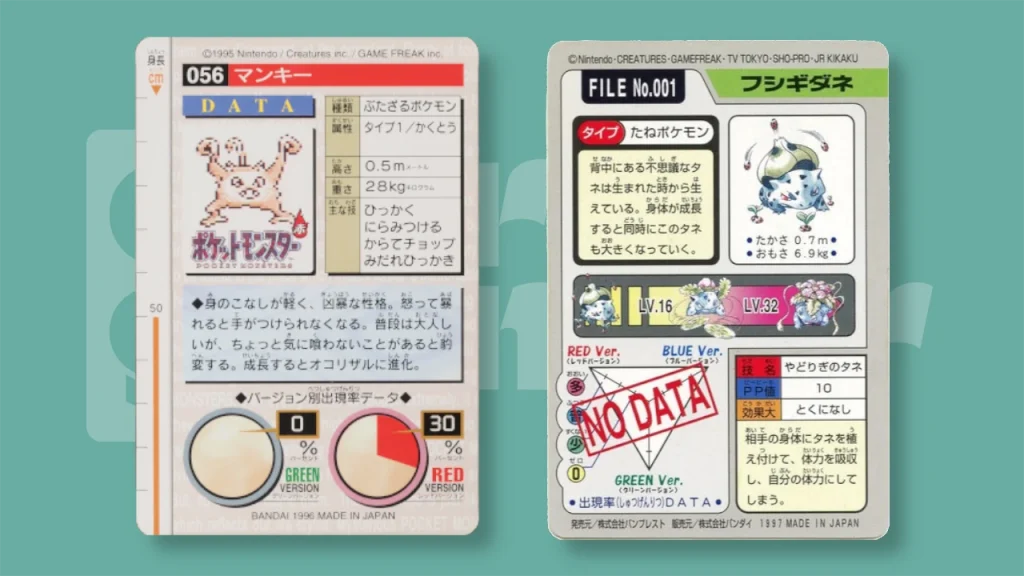

Bandai Carddass Pokemon cards hold a special place as the first Pokemon cards ever produced, yet their obscurity makes them a rarity.
While the 151 Pokemon included in the first two Carddass card sets form the foundation for any collection, promotional cards are highly prized. However, they are less expensive than the most valuable promotional Pokemon TCG cards.
This article may contain affiliate links. If you use these links to purchase an item we may earn a commission. Thank you for your support.
